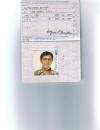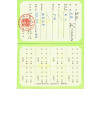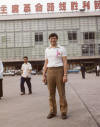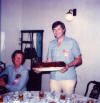







Mainland China: The early Years 1978 to 1981
Having worked in the Far East for over ten years, I knew my way around most countries and their producers, but in 1978 another opportunity for continued exploration was presented to me. I went to work for a low price chain store group located in the Southwest that had just been acquired by a large conglomerate of food retailers in California. The goal of these two firms was to purchase lower priced Men's, Women's and Children's apparel directly from Far Eastern suppliers in the most efficient way. Since this goal fit my previous experience very well, I was hired to open a direct import buying department working out of their offices in Phoenix, AZ as well as my home in the NYC area. This situation would not have been such an interesting story except for a very significant change in the relationship between the USA and the People's Republic of China, referred to at that time as "Communist China." In 1972, President Richard Nixon visited mainland China to explore the possibilities of new and better relationships. (Nixon's visit to China 1972) From February 21 to February 28, 1972, U.S. President Richard Nixon traveled to Beijing, Hangzhou and Shanghai. This historic event began a period of reconciliation between the two countries and an opening of trade relations that would eventually become an overwhelming dependence by the US for manufactured goods from China. The development of trade relations between 1972 and 1978 was a forward moving phenomenon that held a great deal of interest upon the part of apparel importers. (See a brief presentation about this period)
The Canton Fair
The primary means of exposure to China's export product capabilities was through the Canton Fair held in this city now called Guangzhou twice a year since 1957 (see history of Canton Fair). This window into China's potential as a supplier of low cost but good quality products was very slow to open. Interest upon the part of American buyers did not begin until the end of the cultural revolution in China (see history of the "Cultural Revolution") that began in May 1966 lasted officially until 1969, but many China observers think it ended in 1976. In the early 1970's, a few executives from my firm visited the Canton Fair during our regular buying trips to Hong Kong, but returned with reports of very limited selection, questionable quality and a lack of flexibility upon the part of the various textile/apparel "enterprises" exhibiting at the Fair. Over the last decades the Fair has grown in importance to the point where purchases in the hundreds of billions of US$ per session.
Visiting The People's Republic of China
For my first visit, getting invited into China in order to explore various potential sources of consumer goods supply was not simple. In 1978 the US and China diplomatic relations were informal (not fully restored until 1979) so it was an arduous task just to get a visitor's visa. First you had to be invited by one of the "enterprises" through a Chinese government export agency (there were several). After much correspondence over a period of months explaining my firm's interest in developing apparel products for export. my request was approved. That was only the first step. Because the Republic of China government would not allow business person to enter Taiwan if you had a visa stamp from the People's Republic of China in your passport. For this reason, I had to obtain a special US passport for travel to Communist China, North Korea, Vietnam, Albania, Syria and Cuba. With this document in hand I then had to go to the Communist Chinese Liaison office in Washington, DC to obtain the entry visa stamped into this special passport. This was a strange experience primarily because at that time most Americans knew very little about Communist China. I also had a personal bias because of the negative experiences I had while living in HK during the cultural Revolution. The bureaucrats at the Chinese Liaison office at first told me there must have been a mistake as my visa approval was not recorded in their office, however after some polite pressure from me they finally located the paperwork at issued my visa. Next, I had to arrange to fly to Tokyo. There I would make a connection with an Iraqi Airways flight to Beijing, China. My firm had made arrangements to do business through a Hong Kong buying agency, so I meet their representative who traveled to Beijing from HK. Visiting China at this time was like stepping back in time. Everything was operating on a pre 1949 basis when the Chinese Communists gained control of their country. After a few troubling miscues with hotels and meeting up with our HK agent we set out to do business.
Doing Business in the People's Republic of China
Today, most of the difficulties of doing business in China have been lessened to a reasonable degree. However, in October 1978 it was a real challenge even for a seasoned business person that had more than ten years experience in the Far East. The pace of doing business was very slow. There was no urgency on the part of the Chinese to consider new products, make samples, book orders or make deliveries. Our agent and I would start our days having a very simple breakfast in the hotel and then head out for our first appointment by taxi to a nearby office building (built in 1930) at 9am. Usually the persons we were meeting did not show up until 10am because they had to attend a "worker's meeting" to start their day. After some interesting but tedious discussions at 12 noon sharp they would excuse themselves for a 2 hour lunch break. We would go back to our hotel or try to find a good restaurant for lunch. Western food was nowhere in sight, however we both knew what we liked in Chinese cuisine so this was not a problem, except after three weeks of this diet, I did long for some western food. After this long lunch break, we would return to our discussions. Problems were always arising. Their negotiators would often refer back to higher level managers for acceptance of our requests or proposals. Each of these preliminary visits would then end with a request for a return visit. Usually more knowledgeable would attend these subsequent meeting. After a while we realized that the initial visits involved the Chinese who were English speakers but not really decision makers. Although my first visit started in Beijing, I quickly learned that Shanghai was the city where most business was really conducted. Beijing had the government offices and officials who basically passed us on to "enterprises" in Shanghai where the real negotiations took place.
Getting to Know China
Since my first visit was really exploratory, I visited several cities just to see where the most likely suppliers were located. As mentioned above, we started in Beijing moved on to Shanghai. On the way to Shanghai, we visited another "enterprise" in Tientsin (now Tiangin). This city is very historic and played a major role in the westernization of China by the Colonial powers (see the link to Tianjin). Anyone interested in the history of the development of trade relations between China and the West will find this link to be very enlightening. Hubei Province had at that time had recently suffered severe quake damage so many buildings were destroyed, but you could still see the strong western influence in the architecture of the larger buildings. It was in this city that I had many first real experience with two cultural aspects, first Traditional Chinese Opera and in a more modern vein the popularity of Basketball as a sport. From Tianjin we flew to Dalian (Port Arthur), another port city with a great deal of history related to the expansion of western influence in China, in this case by the Russians. This region was quite poor and offered little opportunity for supplier relations. Also this was the only city where we experienced bad Chinese food. Our next stop was in the city of Chungking (Chongqing) in a more western part of China. This city was the wartime (WWII) capital of China. In this case we were asked to attend a play about the courageous struggle of Mao Tse Tung and the Communist Party. Here I was able to see the (Yangtze River) from one of the few bridges across it at that time. For more history of this city see the Chongqing link above. Here again plenty of history but not much opportunity for business. Our last stop on this trip was the city of Canton (Guangzhou) located near Hong Kong, where the expansion of western influence really began. Follow the Guangzhou link for more information. After the (Opium wars) in China (starting in 1839 and ending in 1860) Canton became the main port city for commercial goods moving in and out of China. Here we found several more apparel product suppliers that were good sources of supply. We finally left Communist China and entered Hong Kong after a long and arduous trip, but it was a tremendous experience especially for a young American businessman at that time (see travel schedule).
China Today 30 years later
As I look back on the 1966 to 1981 period in my career, I realize what unusual travel experiences I had enjoyed. I returned to Beijing and Shanghai on a vacation in 2001. I was overwhelmed by the modernization of those two cities since my last visit in 1981 exactly 20 years later. The growth since 2001 has been even more spectacular. For more information about the differences between the (old and new Beijing) try this link. This is also true for Shanghai, even more so then Beijing. Here is another link for (Modern Shanghai). Another city that I recall very vividly is Guangzhou, which the first Chinese city to receive foreign traders in the 18th century. In order to keep foreign influence to a minimum, a small island in the Pearl River was allowed to be controlled by the foreign trading companies. Today, there is an open door to Guangzhou (modern Canton). Below are some photos showing various aspects of the change.



